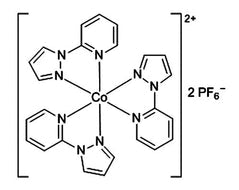FK102-Co(II)PF6 Salt
CAS Number 1392221-69-0
DSSC Dyes & Electrolytes, Materials, Perovskite Interface Materials, Perovskite MaterialsA pyrazole-pyridine cobalt complex
as a dopant for hole transport layer materials
Overview | Specifications | MSDS | Literature and Reviews
Tris(2-(1H-pyrazol-1-yl)pyridine)cobalt(II) di[hexafluorophosphate], commonly known as FK102 Co(II)PF6 Salt, is used as redox electrolyte in DSSC or hole transport and dopant materials in perovskite solar cells.
In comparison to triiodide-based redox electrolytes, cobalt complexes in general increase photovoltages and particularly at lower light levels (e.g. for indoor applications), significantly increase device power output.
Cobalt pyrazol-pyridine complex
A dopant for HTL materials in perovskite solar cells
Worldwide shipping
Quick and reliable shipping
Enhanced energy harvesting
Increase photovoltages and particularly at lower light levels
High purity
>98%
General Information
| Full name | Tris(2-(1H-pyrazol-1-yl)pyridine)cobalt(II) di[hexafluorophosphate] |
| Synonyms | Tris(2-(1H-pyrazol-1-yl)pyridine)cobalt(II) bis[hexafluorophosphate] |
| Chemical formula | C24H21CoF12N9P2 |
| Molecular weight | 784.35 g/mol |
| CAS number | 1392221-69-0 |
| HOMO / LUMO | n/a |
| Solubility | Acetonitrile |
| Classification / Family | Cobalt complex, Hole transport and dopant materials, Dye Sensitized Solar Cell (DSSC) Materials, Hole Conductor Cobalt Dopants, Organic Photovoltaic (OPV) Materials, Organic and Printed Electronics, Perovskite Materials |

Product Details
| Purity | >98% |
| Melting point | 362 oC (lit.) |
| Appearance | Orange powder |
MSDS Documentation
 FK102-Co(II)PF6 Salt MSDS Sheet
FK102-Co(II)PF6 Salt MSDS Sheet
Literature and Reviews
- Sequential deposition as a route to high-performance perovskite-sensitized solar cells, J. Burschka et al., Nature 499, 316–319 (2013); doi:10.1038/nature12340.
- Perovskite solar cells - An overview of critical issues, A.B. Djurišića et al., Prog. Quant. Electron., 1-37 (2017); https://doi.org/10.1016/j.pquantelec.2017.05.002.
- A cobalt complex redox shuttle for dye-sensitized solar cells with high open-circuit potentials, J-H. Yum et al., Nat Commun., 3, 631 (2012); doi: 10.1038/ncomms1655.
